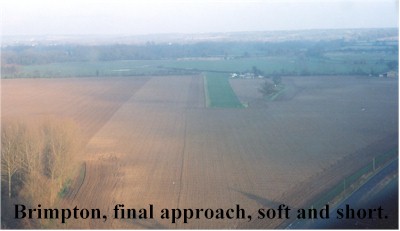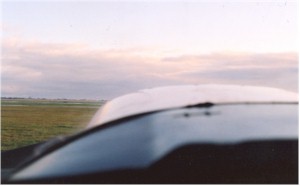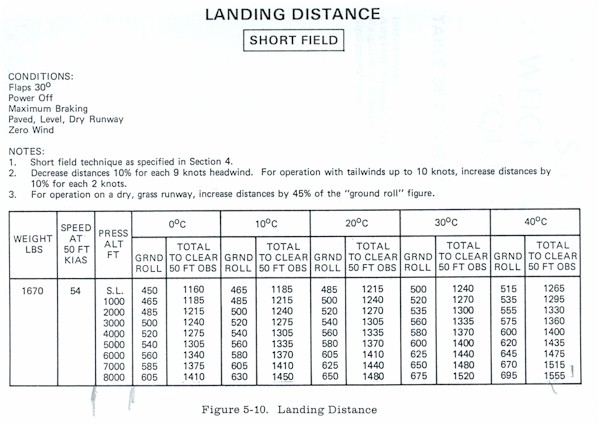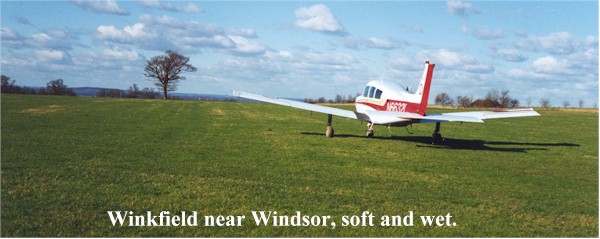

Short Field, and Soft Field.
From time to time we are faced with a landing on a runway that is
short, or a grass runway that has seen weeks of rain, or a runway
that is wet, soft, and short! Add a crosswind into the equation
and we have a lot of work to do, but the satisfaction from using
the skills we have learned is worth the work. Obviously there are
places we should never go; it is up to the pilot to decide
whether a safe landing can be made.
There I was...
...Looking down on the grounds of Carlton
Towers, I was going to land a Boeing on some 300 yards of grass.
I had paced it on foot, I looked at the 80 foot trees on my
approach, I drew a line in my mind parallel to several trees in
the middle of my field, and decided it was possible. Now at a
thousand feet I looked down on this tiny place and began to have
second thoughts.
Prior to leaving Sherburn in Elmett I had practiced a couple of
short field landings, creeping in with 70 MPH on the airspeed
indicator with a little power. Well, if my judgement was correct
I should get in there easily, I wasn't too worried about getting
out again, there was a 450HP P&W 985 in front of me.
I slipped in over the trees to get the maximum angle of descent,
70 on the ASI, flared, and added a little power to reduce the
sink rate. My concentration was total, the aeroplane an extension
of me; the aeroplane touched down gently and rolled to a stop
with loads of room to spare. The Stearman is a big pussycat, a
confident aeroplane.
Later I had to swing the prop a few times with Anjelica Huston at
the controls, and then fly the aeroplane out from a paraffin lit
flare path, and repeat the exercise in the semi dark. I landed at
Sherburn using the "soft field" technique at the end of
an exciting day. To see my effort, see the film "A Handful
of Dust", available on video (a dour story by Evelyn Waugh).

Landing with a high nose up attitude ensures a touchdown
at minimum speed.
Short Field
In the Pilot's Operating Handbook the Short Field Landing is written as follows:
1. Airspeed -- 60-70 KIAS
(flaps up)
2. Wing flaps -- 30º (below 85KIAS)
3. Airspeed -- MAINTAIN 54 KIAS
4. Power -- REDUCE to idle as obstacle is cleared
5. Touchdown -- MAIN WHEELS FIRST
6. Brakes -- APPLY HEAVILY
7. Wing Flaps -- RETRACT

The Pilots Operating Handbook (POH) suggests that
you apply the brakes heavily while retracting the flaps, this is,
as for the above chart from the Cessna 152 POH, on a Paved,
Level, Dry Runway. Even on such a surface you'll probably find
that the nose wheel will shimmy (wobble).
Retracting the flaps is supposed to put more weight on the
mainwheels... This is not a good habit to get into if you are
going to fly more complex aeroplanes in the future since many
undercarriages have been retracted on the ground following the
operation of the wrong switch!
Like all landings each one is different and each will require you
to use the judgement you gain with experience. If the field is
rough you would be wise to keep the nose up for as long as
possible to reduce the possibility of damaging the nose leg.
I like to hear the stall warner just before the wheels touch. The stall warner should work at around 8 knots above the normal stall speed, and if it sounds you will know that you are touching down with minimum forward speed. Control your approach using power as necessary to land as close to the start of the runway as possible, and use full flap.
If the wind is strong and perhaps gusting you should use a higher speed on the approach to enable you to penetrate wind shear safely, I would suggest you use 60 KIAS in winds over 10 knots. If the wind is gusting you should add half the gust to your approach speed. If the wind is 10G20, a ten knot gust, then you should add 5 knots to your approach speed.
Wind shear is caused by the friction between the wind and the ground, the wind speed at ground level is therefore less than at 50 feet which less than at 100 feet and so on... Local geography, trees, hills etc can cause downdrafts so beware; when the wind is strong, read the surrounding terrain for clues, think of air like water in a stream, look at how the water cascades around the rocks, the wind behaves likewise!

Soft Field
The soft field landing is done using 1200 - 1400 RPM during the hold off in the Cessna 152. This way the wheels touch ever so gently so the weight is slowly transferred to the ground with very little sink (descent rate). It is important that the wheels don't drop into the mud and flop you over onto your back!
In training on a hard surface you will throttle back as the wheels kiss the ground softly, but in the real situation you may leave the throttle on until you stop. The slipstream from the propeller enables the elevator to keep the weight off that precious nose wheel and this will reduce the possiblilty of you either breaking the nose leg or digging into the mud with the possibility of hitting the propeller on the ground.
Rough ground requires the same procedure as for the soft field with even more care required to prevent a prop strike. Always cross ruts or from one surface (grass) onto another (concrete) at an angle to reduce the chance of damaging the propeller.
Wherever possible, walk the field before you land there, and then again before you take off.
Next: Lesson 15. Crosswind Landings
© Michael Peare 2002